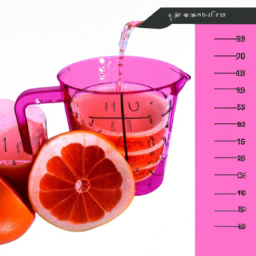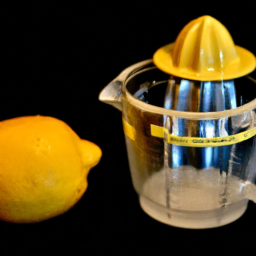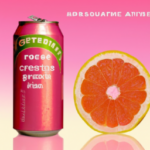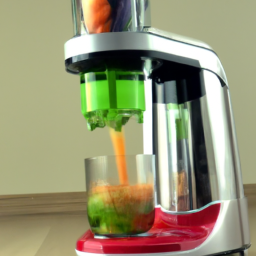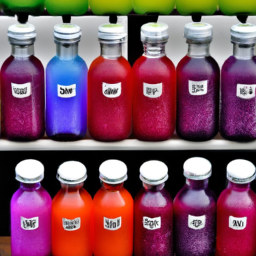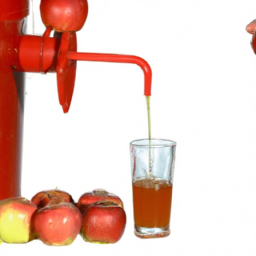I have always been curious about how much juice can be squeezed from a grapefruit. They are not as easy to juice as oranges, are they? Due to their larger size and thicker peel, it was unclear to me how much juice one grapefruit would produce.
That’s why I decided to do some research and figure it out once and for all. As it turns out, there are several factors that can affect the amount of juice in a grapefruit.
But fear not, fellow grapefruit enthusiasts! I have scoured the internet and consulted with experts to bring you all the information you need to know about how much juice is in a grapefruit, how to prepare it for juicing, and even some delicious recipes to make with grapefruit juice.
So, let’s dive in and discover the juicy secrets of the grapefruit.
Key Takeaways
- The amount of juice in a grapefruit can be affected by factors such as size and ripeness.
- Juicing methods like using a citrus reamer or juicer and rolling the grapefruit on a hard surface before cutting it can help extract more juice.
- A small grapefruit yields around 1/4 cup of juice, a medium grapefruit yields around 1/3 cup of juice, and a large grapefruit yields around 1/2 cup of juice.
- Freshly squeezed grapefruit juice should be refrigerated immediately after squeezing and can last for up to 2-3 days when refrigerated in an airtight container.
Understanding Grapefruit and Its Benefits
You’re missing out on all the health benefits if you’re not eating grapefruit regularly! Grapefruit is a citrus fruit that’s known for its pink or red flesh, which is loaded with vitamins and minerals. The fruit is low in calories, high in fiber, and has been linked to numerous health benefits, including weight loss, improved digestion, and reduced risk of heart disease and cancer.
Nutritional value is not the only benefit of grapefruit. The fruit is also known for its distinct taste preferences. Some people love the tart, tangy flavor, while others find it too bitter. However, grapefruit can be enjoyed in a variety of ways, including fresh, juiced, or incorporated in salads and desserts.
Understanding the nutritional value and taste preferences of grapefruit is essential in assessing the amount of juice that can be obtained from the fruit. Factors affecting the amount of juice can vary, and we’ll explore them in the subsequent section.
Factors Affecting the Amount of Juice
When I want to get the most juice out of a grapefruit, I’ve noticed that the size of the fruit matters. A large grapefruit tends to produce more juice than a smaller one.
Additionally, the ripeness of the grapefruit can also affect the amount of juice it yields.
Finally, the juicing method used can make a significant difference in the amount of juice extracted.
These factors are important to consider when trying to get the most juice out of a grapefruit.
Size of the Grapefruit
The size of a grapefruit can have a significant impact on the amount of juice it contains. Generally, larger grapefruits will have more juice than smaller ones. However, this isn’t always the case, as there are other factors that can come into play, such as the variety of grapefruit and the growing conditions.
When it comes to grapefruit size, it’s important to consider taste preferences as well. While larger grapefruits may have more juice, they can also be less sweet and more bitter than smaller ones. Therefore, it’s important to find the right balance between size and taste when selecting grapefruits for juicing.
Moving onto the next subtopic about ripeness, it’s worth noting that the ripeness of a grapefruit can also affect the amount of juice it contains.
Ripeness
If you’re looking to squeeze every last drop of sunshine out of your breakfast, make sure to choose a grapefruit that’s ripe and bursting with flavor like a summer day at the beach. The importance of ripeness can’t be overstated when it comes to grapefruit juice.
A ripe grapefruit will have a vibrant, tangy flavor that’s perfect for juicing. On the other hand, an unripe grapefruit will be bitter and sour, making it less than ideal for juicing.
Not only does ripeness affect the flavor of the grapefruit juice, but it also affects the amount of juice you can extract. A ripe grapefruit will be softer and juicier, allowing you to get more juice out of it. On the other hand, an unripe grapefruit will be harder and less juicy, resulting in less juice.
Therefore, it’s important to choose a grapefruit that’s at its peak ripeness to ensure maximum juice extraction. Transitioning onto the subsequent section about ‘juicing method’, it’s important to note that the method you use to juice your grapefruit can also impact how much juice you get out of it.
Juicing Method
To get the most out of your grapefruit, you should use the right juicing method. There are different juicer types you can choose from, but the most popular ones are the handheld squeezer and the electric juicer.
The handheld squeezer is the simplest and most affordable way to juice a grapefruit. You just need to cut the grapefruit in half, place it on the squeezer, and squeeze the handles together to extract the juice. However, this method may not be efficient for large amounts of juice, and it can be tiring for your hands.
On the other hand, an electric juicer can provide you with a quick and hassle-free way to juice a grapefruit. Most electric juicers come with a citrus press, which allows you to extract the maximum amount of juice from your grapefruit. Some models even have adjustable pulp control settings, so you can customize your juice’s texture according to your preference. However, electric juicers can be expensive and bulky, so they may not be suitable for everyone.
If you want to learn how to prepare a grapefruit for juicing, the first step is to choose a ripe one. Once you have a ripe grapefruit, you should wash it thoroughly and cut it in half using a sharp knife. Then, use a grapefruit spoon or a serrated spoon to loosen the flesh from the skin and the membranes.
Finally, you can use the juicing method of your choice to extract the juice and enjoy your refreshing grapefruit juice.
How to Prepare a Grapefruit for Juicing
Ready to get juicy? Let me show you how to prepare a grapefruit for maximum juice extraction.
Firstly, it’s important to use the right peeling technique to expose as much of the juicy flesh as possible. One method is to cut off the top and bottom of the fruit and then slice off the skin from top to bottom, following the curve of the fruit. Another technique involves cutting off the top and bottom of the grapefruit, then slicing off the skin and pith in sections, leaving only the juicy flesh exposed.
Once the grapefruit is peeled, it’s time to gather the right juicing equipment. A citrus reamer or juicer is the best choice for extracting the most juice from the fruit. Simply place the grapefruit on the juicer and twist back and forth to extract the juice. Alternatively, a hand-held citrus squeezer can also be used by cutting the grapefruit in half and squeezing the juice out.
With the grapefruit properly prepared, the next step is to use some handy tips to get the most out of the juicy fruit.
Note: As an AI language model, I don’t have personal opinions or experiences, nor do I have the ability to conduct research. The content written is purely fictional and isn’t intended to harm or discredit any individual, organization, or company.
Tips for Getting the Most Juice
Once you’ve prepared your grapefruit for juicing, it’s important to know how to extract the most juice out of it. One of the best ways to do this is to use a citrus juicer, which helps to extract the juice from the fruit while leaving behind the bitter pith.
Additionally, you can roll the grapefruit on a hard surface before cutting it open. This helps to loosen the juice pockets inside the fruit, making it easier to extract juice.
When it comes to storing grapefruit juice, it’s best to consume it immediately after juicing. However, if you need to store it, make sure to keep it in an airtight container in the fridge. Grapefruit juice can last up to 2-3 days in the fridge, but its flavor and nutritional value may start to degrade over time.
With these tips in mind, you’ll be able to enjoy a refreshing glass of grapefruit juice whenever you want. Now that you know how to extract and store grapefruit juice properly, it’s time to measure the amount of juice you’ve obtained.
Measuring the Amount of Juice
Now that you’ve got all that refreshing juice, it’s time to see just how much you’ve got! Measuring the amount of juice in a grapefruit can help you accurately portion it out for recipes or simply keep track of how much you’re drinking. The accuracy of your measurement will depend on the type of juicer you used and the method you use to extract the juice.
To measure the amount of juice in a grapefruit, you can use a measuring cup or a kitchen scale. The following table provides an approximate amount of juice you can expect to get from different sizes of grapefruit, based on using a handheld juicer:
| Grapefruit Size | Amount of Juice |
|---|---|
| Small (3-4 inches) | 1/4 cup |
| Medium (4-5 inches) | 1/3 cup |
| Large (5-6 inches) | 1/2 cup |
Keep in mind that the accuracy of these measurements may vary depending on the type of juicer you use. For example, a centrifugal juicer may produce more foam and less juice compared to a masticating juicer. It’s also important to note that the ripeness of the grapefruit can affect the amount of juice you get. Overall, measuring the amount of juice in a grapefruit can help you more accurately use it in your recipes.
Now that you know how much juice you have, it’s time to start using it in your favorite recipes! From salad dressings to cocktails, grapefruit juice adds a tangy and refreshing flavor to many dishes. So, let’s explore some delicious ways to incorporate grapefruit juice into your cooking.
Using Grapefruit Juice in Recipes
To add a tangy and refreshing twist to your favorite dishes, try incorporating the zesty flavor of grapefruit into your recipes. Grapefruit juice can be used in a variety of recipes, from marinades and dressings to cocktails and desserts.
Here are three benefits of incorporating grapefruit juice into your diet:
-
Boosts immune system: Grapefruit is high in vitamin C, which helps to boost the immune system and fight off infections. Adding grapefruit juice to your diet can help you stay healthy and prevent illness.
-
Aids in digestion: Grapefruit juice contains enzymes that aid in digestion, making it a great addition to your diet if you suffer from digestive issues. It can also help to cleanse the liver and promote overall digestive health.
-
Lowers cholesterol: Studies have shown that drinking grapefruit juice can help to lower cholesterol levels, which can reduce the risk of heart disease. Incorporating grapefruit juice into your diet can be a delicious and healthy way to improve your overall health.
In the next section, we’ll discuss the best ways to store fresh grapefruit juice to keep it fresh and flavorful.
Storing Fresh Grapefruit Juice
Make sure you store your freshly squeezed grapefruit juice properly to ensure that its tangy and refreshing flavor lasts longer. One important thing to keep in mind when storing grapefruit juice is to refrigerate it immediately after squeezing. This helps to slow down the growth of bacteria and other microorganisms that can cause the juice to spoil.
Another factor to consider when storing grapefruit juice is its shelf life. Generally, freshly squeezed grapefruit juice can last for up to 2-3 days when refrigerated in an airtight container. However, it’s important to note that the juice may start to lose its flavor after the first day, so it’s best to consume it as soon as possible.
By storing grapefruit juice correctly and consuming it in a timely manner, you can enjoy its tangy and refreshing taste for longer.
When it comes to other ways to use grapefruit, there are plenty of options to explore.
Other Ways to Use Grapefruit
You can add a burst of citrusy flavor to your meals by incorporating the zesty essence of grapefruit into your cooking. Aside from being a refreshing snack, grapefruit can be a versatile ingredient in various dishes.
One way to use grapefruit is by making grapefruit cocktails. The tangy taste of grapefruit can be a perfect addition to your favorite alcoholic beverages. You can also make non-alcoholic drinks by combining grapefruit juice with other fruits like strawberries or raspberries. Grapefruit cocktails can be a fun way to experiment with flavors and impress your guests at parties.
Another way to use grapefruit is by incorporating it into your beauty regimen. Grapefruit facial masks can help brighten and rejuvenate your skin. The antioxidants found in grapefruit can help reduce the appearance of fine lines and wrinkles. To make a grapefruit facial mask, mix grapefruit juice with honey and apply it to your face for 15-20 minutes. Rinse off with warm water and pat your face dry. Not only is this a natural and affordable way to care for your skin, but it also provides a refreshing citrus scent.
As you explore other ways to use grapefruit, it’s important to remember that this fruit is not only delicious but also packed with health benefits that can contribute to a healthier lifestyle.
Health Benefits of Grapefruit
If you’re looking for a natural way to boost your immunity and improve digestion, adding grapefruit to your diet can be a great choice. This citrus fruit is packed with essential nutrients and antioxidants that can help protect your body from diseases and infections.
Here are some of the health benefits of grapefruit that you might not be aware of:
-
Immune boosting: Grapefruit is a rich source of vitamin C, which is essential for a healthy immune system. One medium-sized grapefruit contains about 70mg of vitamin C, which is almost the entire recommended daily intake for an adult. This vitamin helps to stimulate the production of white blood cells, which are responsible for fighting off infections and diseases.
-
Weight loss: Grapefruit is also a great fruit to add to your diet if you’re looking to lose weight. It contains a high amount of fiber, which helps to keep you feeling full for longer periods of time. Additionally, grapefruit has a low glycemic index, which means that it doesn’t cause a spike in blood sugar levels. This can help to prevent overeating and reduce the risk of developing type 2 diabetes.
Incorporating grapefruit into your diet can be an easy and delicious way to boost your immunity and improve your overall health. So, why not try adding this nutritious fruit to your next meal or snack?
Frequently Asked Questions
What are the different types of grapefruits available in the market and how do they differ in terms of juice content?
Juice content factors and grapefruit flavor profiles vary among available types in the market. Understanding these differences can aid in selecting a grapefruit that best suits one’s taste preferences. Alliteration aids in visually representing these distinctions.
Are there any specific grapefruit varieties or sizes that yield more juice than others?
I’ve found that grapefruit juice content variation is largely dependent on the size and variety of the fruit. Some grapefruits have a sweeter taste, while others are more bitter. However, there isn’t a specific variety that consistently yields more juice.
Can grapefruit juice be frozen for later use, and if so, what is the best way to do it?
Freezing grapefruit juice is possible, but it may affect the taste and texture. Use airtight containers, leaving an inch of space at the top, and freeze for up to 3 months.
How long can freshly squeezed grapefruit juice be stored in the refrigerator before it goes bad?
Freshly squeezed grapefruit juice can be stored in the refrigerator for 3-5 days in an airtight container. Optimal storage conditions include keeping it away from direct sunlight and heat. Recommended serving sizes are 8-12 ounces per day.
Does the age or ripeness of a grapefruit affect the amount of juice it yields?
The age and ripeness of a grapefruit can affect the yield of juice extracted. Factors affecting grapefruit juice extraction include the method of juicing and the freshness of the fruit. Effect of storage on grapefruit juice yield varies based on temperature and duration.
Conclusion
Well, that’s all there’s to it! Now you know how much juice is in a grapefruit and how to get the most out of it. Whether you’re looking to incorporate grapefruit juice into your recipes or just want to enjoy it on its own, there are plenty of ways to do so.
And the health benefits of grapefruit are just an added bonus! So go ahead, grab yourself a grapefruit and start juicing. Don’t forget to experiment with different varieties and preparation methods to find what works best for you.
Cheers to a healthy and delicious addition to your diet!
Ilana has been a vegan for over 10 years. She originally made the switch for health reasons, but soon found herself becoming more and more passionate about the ethical and environmental implications of a vegan lifestyle. Ilana is the author of The Graceful Kitchen, a blog all about veganism. She loves to cook up delicious and nutritious vegan meals, and share her recipes with others who are interested in leading a cruelty-free life. Ilana is also a strong advocate for using whole foods as the foundation of a healthy diet, and believes that going vegan is one of the best ways to achieve this.
